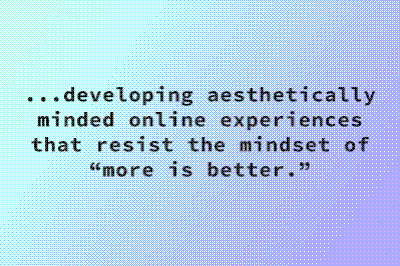Towards More Sustainable Web Experiences
Aug 26, 2022

Check check, is this thing on?
It's been a while since I have posted here. Life has a way of creating roadblocks to producing things for no particular goal/plan/program. But I am back here today to write a little bit about this site in advance of a class I am teaching this semester on web development for artists. As I state on my about page, this site was designed and coded by me with some particular parameters in mind:
- The site is designed to run as efficiently as possible and to only serve high quality images and videos when you arrive at pages related to specific projects as a method of reducing the overall environmental impact of the site. This is why you will see dithered images on many pages (including this one) in place of standard images. This effort is guided by the ideas laid out in the Sustainable Web Manifesto and the accompanying resource https://sustainablewebdesign.org/.
- The site also aims to be accessible to a broad range of people by having mobile friendly design, good alt text (though I recently discovered some errors I need to correct on this front), and high contrast between background and font colors.
- The site does not track or collect user data in any way, this is a good article about why this is important by the LA Times, it covers cookies and data privacy.
When thinking about what considerations should define the redesign of my site, it was important for me to frame the work not as trying to “solve” the problems of data privacy, climate change, or accessibility, but rather to practice bringing into the world something that took these considerations seriously.
In particular, on the issue of environmental impact, I do not think the design choices I have made will make a very noticeable impact on my carbon footprint given the scope of my work and this site's traffic. But where I do think it will have an impact is in helping me enact a way of developing aesthetically minded online experiences that resist the mindset of “more is better.” This mindset constantly surrounds tech from people chasing down the highest resolution/fidelity in their files and hardware, to GPUs for crypto mining and crypto markets more broadly, to the promises of machine learning/artificial intelligence, and on and on. We are suffocating and toxifying the planet in the quest for what capitalism defines as more. We do not need the type of “more” that the world of tech largely aspires to, instead we need:
- More access
- More diversity
- More compassion
- More community
- More introspection
- More stewardship
So, this site and its design won’t save the world, it won’t solve a problem, and it doesn’t do all of the things listed above but it might help me (and hopefully my students) continue to practice bringing more humane tech into the world. This is critically important because despite all of these problems (or, in fact, because of them) we need artists to continue engaging with the material of the internet, to challenge and complicate what it means to exist and create online.
The above thinking helped me design an assignment that has been published as an open access resource by San Jose State University: Building a More Sustainable and Accessible Internet: Lightweight Web Design with HTML and CSS. I hope to host a revised version of this assignment on my site after using it and refreshing it in a course this fall.
In all of this, I am inspired by other artists, developers, and writers working on these issues, here are some things I have been/want to read/watch/listen to:
- DISNOVATION.ORG (all of their work but in particular their Post Growth Prototypes)
- The Future Is Degrowth: A Guide to a World beyond Capitalism by Matthias Schmelzer, Aaron Vansintjan, and Andrea Vetter
- How to Build a Low-Tech Website? By Low-tech Magazine
- Branch
- Post-Growth Living: For an Alternative Hedonism by Kate Soper
- The Vanilla JS Podcast: Web Development and Climate Change
- Sustainable Web Manifesto
- Sustainable Web Design